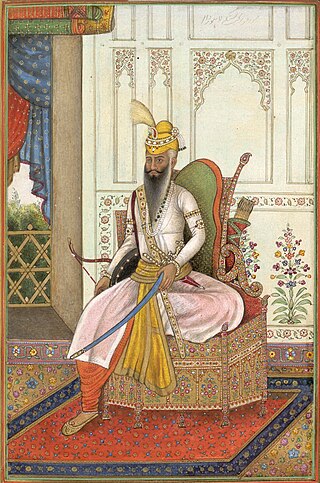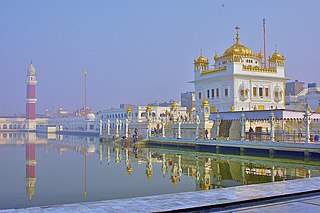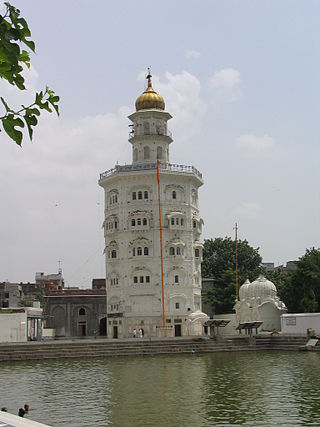
Amritsar, historically also known as Rāmdāspur and colloquially as Ambarsar, is the second-largest city in the Indian state of Punjab, after Ludhiana. It is a major cultural, transportation and economic centre, located in the Majha region of Punjab. The city is the administrative headquarters of the Amritsar district. It is situated 217 km (135 mi) north-west of Chandigarh, and 455 km (283 mi) north-west of New Delhi. It is 28 km (17.4 mi) from the India-Pakistan border, and 47 km (29 mi) north-east of Lahore, Pakistan.

Ranjit Singh, popularly known as Sher-e-Punjab or "Lion of Punjab", was the first Maharaja of the Sikh Empire, which ruled the northwest Indian subcontinent in the early half of the 19th century. He survived smallpox in infancy but lost sight in his left eye. He fought his first battle alongside his father at age 10. After his father died, he fought several wars to expel the Afghans in his teenage years and was proclaimed as the "Maharaja of Punjab" at age 21. His empire grew in the Punjab region under his leadership through 1839.

Navjot Singh Sidhu is an Indian National Congress politician, television personality and retired international cricketer. He is the former President of Punjab Pradesh Congress Committee. Formerly, he was the Minister of Tourism and Cultural Affairs in the state government of State of Punjab.

Tarn Taran Sahib is a city in the Majha region of the state of Punjab, in northern India. It is the district headquarters and hosts the municipal council of Tarn Taran district. Gurdwara Sri Tarn Taran Sahib, a prominent Sikh shrine is located in the central part of the city.

The Akal Takht is one of five takhts of the Sikhs. It is located in the Darbar Sahib complex in Amritsar, Punjab, India. The Akal Takht was built by Guru Hargobind as a place of justice and consideration of temporal issues; the highest seat of earthly authority of the Khalsa and the place of the Jathedar, the highest spokesman of the Sikhs.
Bazigar, or Goaars, are an ethnic group of north-western India. They are primarily found in Punjab and in Pakistan's Punjab, but there are also communities in Haryana, Uttar Pradesh, Delhi, Chandigarh, Himachal Pradesh, Jammu and Kashmir, and Rajasthan. They were previously nomadic with their main occupation the performance of acrobatics and other forms of entertainment, but they are now settled and engaged mainly in agricultural and similar forms of labour.

Gurdwārā Bābā AṭṭalRai is a famous Gurdwara in Amritsar dedicated to Atal Rai, a son of Guru Hargobind and Mata Nanaki. It consists of nine-stories and is around forty metres in-height. It is just a short walk from the famous Harmandir Sahib.
The Khangura is a gotra of Jat community from the Punjab region in India.

The Sikh diaspora is the modern Sikh migration from the traditional area of the Punjab region of South Asia. Sikhism is a religion native to this region. The Sikh diaspora is largely a subset of the Punjabi diaspora.
The Sikhs are adherents to Sikhism, the fifth largest organized religion in the world, with around 25 million adherents. Sikh History is around 500 years and in that time the Sikhs have developed unique expressions of art and culture which are influenced by their faith and synthesize traditions from many other cultures depending on the locality of the adherents of the religion. Sikhism is the only religion that originated in the Punjab region with all other religions coming from outside Punjab. All the Sikh gurus, many saints, and many of the martyrs in Sikh history were from Punjab and from the Punjabi people. Punjabi culture and Sikhism are mistakenly considered inseparably intertwined. "Sikh" properly refers to adherents of Sikhism as a religion, strictly not an ethnic group. However, because Sikhism has seldom sought converts, most Sikhs share strong ethno-religious ties, therefore it is a common stereotype that all Sikhs share the same ethnicity. Many countries, such as the U.K., therefore misconcievingly recognize Sikh as a designated ethnicity on their censuses. The American non-profit organization United Sikhs has fought to have Sikhs included on the U.S. census as well, arguing that Sikhs "self-identify as an 'ethnic minority'" and believe "that they are more than just a religion".
Jandiala Guru, commonly known as Jandiala, is a town in the Amritsar district of Punjab, India. It is located on the Grand Trunk Road, and has an altitude of 229 m (754 ft).

Punjab, known historically as Panchanada or Pentapotamía, is a state in northern India. Forming part of the larger Punjab region of the Indian subcontinent, the state is bordered by the Indian states of Himachal Pradesh to the north and northeast, Haryana to the south and southeast, and Rajasthan to the southwest; by the Indian union territories of Chandigarh to the east and Jammu and Kashmir to the north. It shares an international border with Punjab, a province of Pakistan to the west. The state covers an area of 50,362 square kilometres, which is 1.53% of India's total geographical area, making it the 19th-largest Indian state by area out of 28 Indian states. With over 27 million inhabitants, Punjab is the 16th-largest Indian state by population, comprising 23 districts. Punjabi, written in the Gurmukhi script, is the most widely spoken and the official language of the state. The main ethnic groups are the Punjabis, with Sikhs (57.7%) and Hindus (38.5%) as the dominant religious groups. The state capital is Chandigarh, a union territory and also the capital of the neighbouring state of Haryana. Three tributaries of the Indus, viz., Sutlej, Beas, and Ravi, flow through Punjab.

The Golden Temple is a gurdwara located in the city of Amritsar, Punjab, India. It is the preeminent spiritual site of Sikhism. It is one of the holiest sites in Sikhism, alongside the Gurdwara Darbar Sahib Kartarpur in Kartarpur, and Gurdwara Janam Asthan in Nankana Sahib.

The Nat are a Hindu caste found in northern India.
The Sikligar is a community found in the Indian states of Gujarat, Haryana, Rajasthan, and Punjab. By tradition, the Sikligar people specialized in the craft of making and polishing weapons. They are typically Hindu in Gujarat, Telangana, and Andhra Pradesh; Sikh in Punjab; and either Hindu and Sikh in Haryana.
The Sirkiband are a Hindu caste found in the states of Haryana and Punjab in India. They have scheduled caste status in Haryana. A small number in Punjab are now Sikh.
Mao Sahib is a village and the birthplace of Mata Ganga in Jalandhar district of Punjab State, India. It is located 10 km from Phillaur, 14 km from Nurmahal, 47 km from district headquarter Jalandhar and 120 km from state capital Chandigarh. The village is administrated by a sarpanch who is an elected representative of village as per Panchayati raj (India).
Sikh art, also known as the Sikh School, is the artwork created by or associated with Sikhs. Sikh artwork exists in many forms, such as miniature, oil, and watercolour paintings, murals, and wood carvings.
Amritsar is a city situated in the state of northern Punjab, the northwestern region of India. It is 25 kilometres away from the Pakistan border. This important Punjab city is the main centre of commerce, culture, and transportation. It is the centre of Sikhism and the principal place of worship for Sikhs. Amritsar is attractive destination for tourists, especially those part of Golden Triangle. Major destinations are:
Amritsar is and was the second largest city of East Punjab and United Punjab. It is a Big Commercial, Trading, Textile and Tourist hub of Punjab. There is a proposed Software Technology Park at Amritsar to make it an IT hub. This STPI centre will be functional by the next fiscal year.












